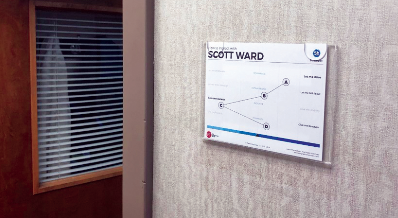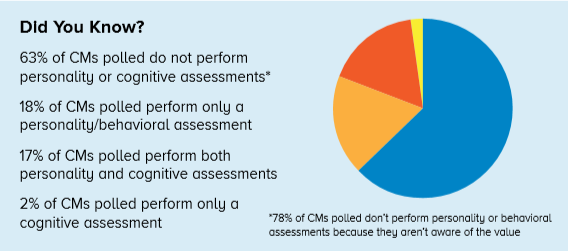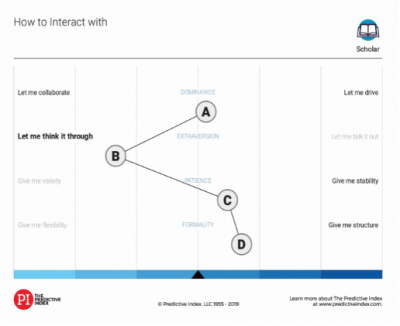How to Hire and Build High-Performing Teams
How to Hire and Build High-Performing Teams
“I believe that most people are typically hired for what they know,” says Scott Ward, principal officer at Southern Components, Inc. in Shreveport, Louisiana. However, Scott argues that if their personality isn’t a good fit for the position, people ultimately don’t work out. “The Predictive Index (PI) assessments can’t fix everything for you, but it sure will help with turnover and make the hiring process easier.”
Scott explains that the PI assessment was a solution for his company to make better hiring decisions when evaluating candidates for a given position. “What we came to realize is that we were continually placing people in positions they were not suited for personality-wise or mentally in some cases. This had to stop if we were going to grow effectively.”
SBCA members receive a 10% rebate on their Year 1 subscription to the Predictive Index software purchased through Business Results, LLC. The rebate will be provided as a credit on the individual member’s SBCA account and can be applied against any SBCA member purchase (e.g., products/services, education, BCMC, dues, etc.).
Reading PI Results
An individual’s PI results show their personality profile and tendencies as it relates to dominance, extraversion, patience, and formality. “Everyone has a measure of the four factors and have a lower (left) or higher (right) expression. The farther the factors get from the midpoint, which is the average of that pattern, the more broadly expressed those factors are and therefore their motivating needs,” explains Dolly Penland, president and CEO of Business Results, LLC.
Figure 1. Click to enlarge.
“For this individual’s example (Figure 1), their dominance is right on the line, they have their extraversion to the left so they’re not going to be really outgoing and want to interact with folks, they have some patience and they’re pretty formal,” says Scott.
Mike Kozlowski, president of Apex in Jacksonville, Florida, explains why this profile (Figure 1) would be good for a truss designer. “A higher A than B shows more dominance than extraversion so this person is going to generally be more task-driven. That’s what you’re looking for in a truss designer because they’re going to be looking to get that next task done. If it’s switched with a higher B than A that means that person is more of an extravert and people-first, so they’re going to be more of a people-pleaser. This is the type of profile we would want on our front line communications. Someone that’s going to make our clients laugh and smile, someone that’s a high B that’s going to be really fun to talk to on the phone and that’s going to be totally focused on the client.”
Another advantage to personality assessments is knowing your own profile and how that may affect your interactions with people. Mike was not surprised with his own PI results and felt they helped him to better understand what he needed as an employee. “The results were exactly what I expected,” says Mike. “What’s neat is that it really let me know how I needed to be managed or led as I was coming up in my career and so I was quick to talk to our CEO and tell him what I needed in order to be successful. I need accolades because I’m a high B. I want to hear that I’m doing a good job. I need to know that the company is pleased with what I’m doing.”
Ideal Candidate: Meets or Exceeds Target Profile
Not An Ideal Candidate: Below Target Profile
Figure 2
Creating Target Profiles
One of the practical uses of the PI program is creating target profiles for every position in your company so you can tell how close a candidate’s profile matches your preferred target.
Scott takes advantage of target profiles and uses them as overlays to determine how close a candidate is to the target profile his company is looking for. “This is an example of a great candidate (Figure 2),” says Scott. “She took the PI and automatically was a match; you can see how close it is to our ideal candidate profile, so it was really easy to hire her. She already had the personality for it.”
Mike shares the same perspective. He looks for a similar profile when finding good designer candidates. “The D is oftentimes what we’re really focused on because it’s that formality and attention to detail that you’re looking for in designers. You really want someone with a higher D so as you start to look at these and think about the different positions that you have, it really sheds light on who might be a good fit in that position.”
Scott has learned from experience that hiring someone that doesn’t meet the desired profile for a position results in a bad fit for that position. “If you cheat the system, you’re probably not going to like the results. I’ve allowed us to make three hires that cheated the system,” explains Scott. “Either a lower cognitive score than I really wanted or a personality profile that wasn’t a right fit. Every single one of those people did not do well at their jobs and have failed or have gone on because we had to cut them loose.”
Getting Started
To get employees to buy-in on the assessments, Scott urges managers to explain why the evaluation is important and how it will benefit the company. “Our turnover was killing us,” says Scott. “We realized we were setting up our new hires to fail. We had to make a culture change and that’s where the PI came in.”
Another tip Scott shares is implementing the evaluations with your leadership team first. “Everything starts with your leadership, so I wanted to make sure that the office staff and everyone that was in a position of management took the personality and the cognitive assessments,” explains Scott. “I had to take it, even my dad did it and he’s not even working much anymore, but he wanted to because it was that important.”
Mike agrees that tact is needed when approaching your employees with the evaluation as you may get some pushback. “Carefully craft the message, that it has nothing to do with your training, your education, or who you are. There are no failing grades. It’s where you most naturally want to behave and I’ll send them my PI so they can see it,” adds Mike. “You want to make sure everyone understands what we’re doing and they don’t take it the wrong way. There’s so much at stake here.”
Improving Employee Interactions & Building Teams
Understanding a person’s tendencies and personality profile can help improve communication among employees and build stronger teams. “I have several different teams and these teams are working together day in and day out and it’s pretty important to know how you communicate, how you make decisions, and how you collaborate,” says Mike. “What the tool does is it’ll actually give you a report that will place each person somewhere, whether it’s drivers, implementers, influencers and how that works is really valuable for us as we build our teams and create new teams.”

Scott adds that his company keeps the profile graphs by their offices as a reminder (see photo). “There’s a graph you can print off and I’ve added everyone’s placard to their office door so that we can remember how to interact with each other,” says Scott. “It’s much easier to remember who we are dealing with if that reminder is there every day.”
Scott and Mike argue it’s easy to implement because it’s all digital and available through an internet browser. It also provides quick, essential insight to potential candidates. “It’s pretty powerful,” says Scott. “You get to see how a person really is before you ever hire them. This stuff is all online now, it’s so simple. HR just sends them a link, they fill it out online, and we’ll get the results a few minutes after they’re done.”
Dolly explains that managers can use this data to better understand the unique strengths of each team member to manage their teams more effectively. “We want to have a deep understanding of how people are going to interact so we can create high performing teams. I encourage managers and leaders to use the data to develop management strategies and look at their direct team members to know how to best interact with them.”
There are numerous benefits to evaluating employees and potential employees using tools like the PI to get to know your employees. “My hope is that you will see the benefits of using this type of program,” says Scott. “These types of tools will help you manage your people more effectively, it’ll help you build your teams and teach them how to work together. It’s something that we all need help with.”
To learn more about personality and cognitive evaluations and how they could benefit your company, read these SBC Magazine articles: “Job Satisfaction: The Right Jobs for the Right People” and “Predict a Candidate’s Job Performance Before They’re Hired.”





